Swamp soup is a beloved dish in the Southern United States, known for its hearty and comforting flavors. This soup is a perfect blend of turnip greens, smoked sausage, and white beans, creating a meal that is both satisfying and nutritious. As the weather cools down, there’s nothing quite like a warm bowl of swamp soup to chase away the chill. Let’s dive into the world of swamp soup, exploring its origins, key ingredients, and the best ways to make it at home.
What is Swamp Soup?
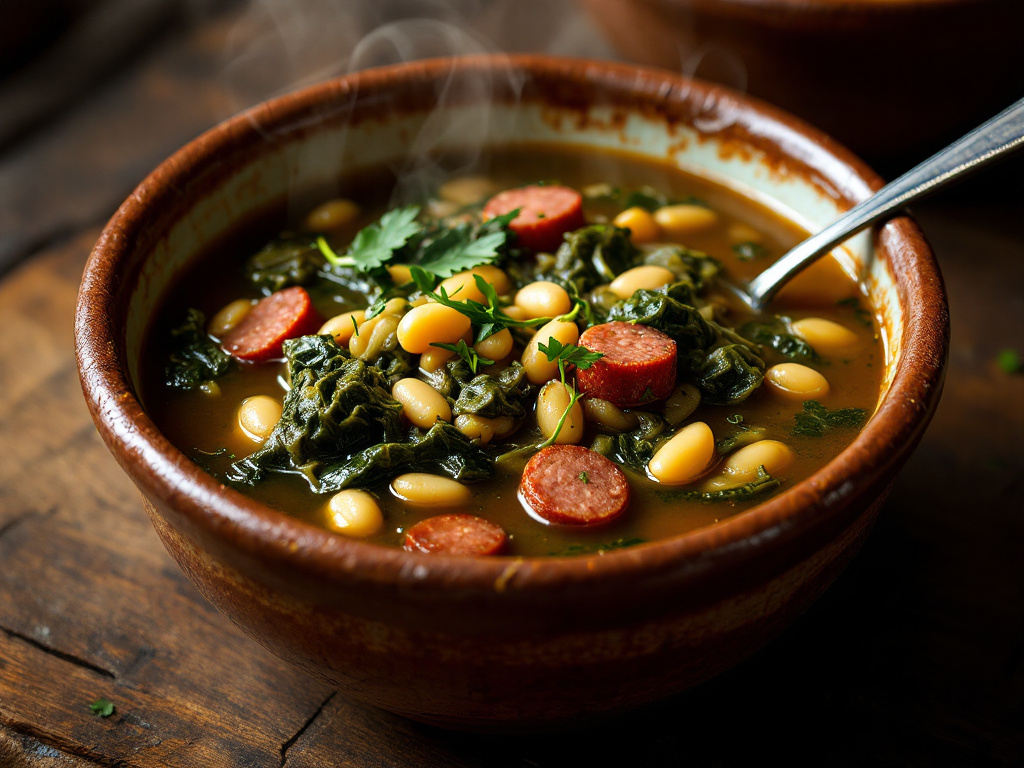
Swamp soup is a traditional Southern dish that gets its name from its rustic appearance, reminiscent of a swamp with greens floating on top. Despite its humble name, this soup is packed with flavor and nutrients. The exact origins of swamp soup are unclear, but it is believed to have emerged from the regions with abundant swamplands in the Southern U.S. The soup is a testament to the resourcefulness of Southern cooks, who have long made use of locally available ingredients to create delicious and hearty meals. For a detailed recipe and background on swamp soup, check out this Southern swamp soup recipe.
The soup features all the major food groups and tons of flavor, making it a delicious meal unto itself. One of the most popular combinations includes turnip greens, smoked sausage, and white beans. However, the recipe is highly adaptable, allowing for various customizations based on personal preferences and available ingredients. Explore different variations and customizations for turnip green soup in this insightful guide on turnip green soup variations.
The cultural significance of swamp soup in the Southern U.S. is profound. It represents the region’s history, hospitality, and the comfort of home-cooked meals. The soup is often served at family gatherings, community events, and during the colder months when a hearty meal is most appreciated. Its versatility makes it appealing to various dietary preferences, whether you’re looking for a comforting meal or a way to incorporate more greens into your diet.
Key Ingredients

Turnip Greens
- Role in the Soup: Turnip greens are the star ingredient, giving the soup its distinctive flavor and appearance. They provide a slightly bitter yet refreshing taste that complements the other ingredients.
- Nutritional Benefits: Rich in vitamins A, C, and K, turnip greens are an excellent source of nutrients. They are also high in fiber, which aids in digestion.
- Selection and Preparation: Choose fresh, vibrant turnip greens with no signs of wilting. Rinse them thoroughly to remove any dirt or grit before chopping.
Smoked Sausage
- Types of Sausage: Andouille or kielbasa are commonly used for their smoky flavor. Andouille offers a spicy kick, while kielbasa provides a milder, garlicky taste.
- Flavor Contribution: The sausage infuses the soup with a rich, smoky taste that complements the greens and beans. It adds depth and complexity to the overall flavor profile.
- Choosing the Best Sausage: Opt for high-quality, locally sourced sausage if available. Look for sausages with a good balance of fat and meat for the best flavor.
White Beans
- Types of Beans: Cannellini, Great Northern, or navy beans are popular choices. Each offers a slightly different texture and flavor.
- Texture and Nutritional Value: White beans add a creamy texture and are packed with protein and fiber. They help thicken the soup and make it more filling.
- Cooking Tips: Rinse and drain canned beans to reduce sodium content. If using dried beans, soak them overnight before cooking to improve digestibility.
Additional Ingredients
- Onions, Garlic, Chicken Broth, Pasta: These ingredients form the base of the soup, adding depth of flavor and heartiness. Onions and garlic provide a savory foundation, while chicken broth adds richness. Pasta like ditalini absorbs the flavors and adds substance to the soup.
- Seasonings and Spices: Customize the soup with your favorite seasonings to enhance the flavors. Consider adding bay leaves, thyme, or a pinch of red pepper flakes for extra warmth.
Variations and Customizations
Bean Variations
- Experiment with different types of beans like black-eyed peas or lima beans for a unique twist. Black-eyed peas offer a slightly different texture and a mild, earthy flavor. Lima beans provide a creamy texture similar to white beans.
- Creative Combinations: Mix and match beans to create a unique flavor profile. For example, combine cannellini and kidney beans for a heartier soup.
Vegetable Additions
- Add finely diced bell peppers or carrots for extra nutrition and flavor. Bell peppers provide a slight sweetness and a pop of color, while carrots add a subtle crunch and natural sweetness.
- Seasonal Vegetables: Incorporate seasonal vegetables like butternut squash or sweet potatoes for a fall-inspired twist. These vegetables add a hearty, comforting element to the soup.
Greens Alternatives
- Substitute turnip greens with collard greens, mustard greens, or spinach for a different taste. Collard greens offer a similar slightly bitter flavor, while mustard greens provide a peppery kick. Spinach adds a milder, more delicate flavor.
- Nutritional Benefits: Each type of green offers unique nutritional benefits. Collard greens are high in calcium, mustard greens are rich in antioxidants, and spinach is packed with iron.
Sausage Options
- Use chicken or turkey sausage for a milder flavor, or add meatballs for a heartier version. Chicken sausage offers a leaner protein option, while turkey sausage provides a slightly different flavor profile.
- Spicy Variations: For a spicier soup, consider using chorizo or a spicy Italian sausage. These sausages add a bold, robust flavor that complements the greens and beans.
Vegetarian and Vegan Options
- Omit the sausage and use vegetable broth for a meat-free version. Add extra vegetables or beans to enhance the soup. Consider adding mushrooms for a meaty texture and umami flavor.
- Vegan Adjustments: Ensure all ingredients are plant-based. Use olive oil instead of butter for sautéing, and opt for vegetable bouillon cubes or paste for added flavor.
Step-by-Step Recipe
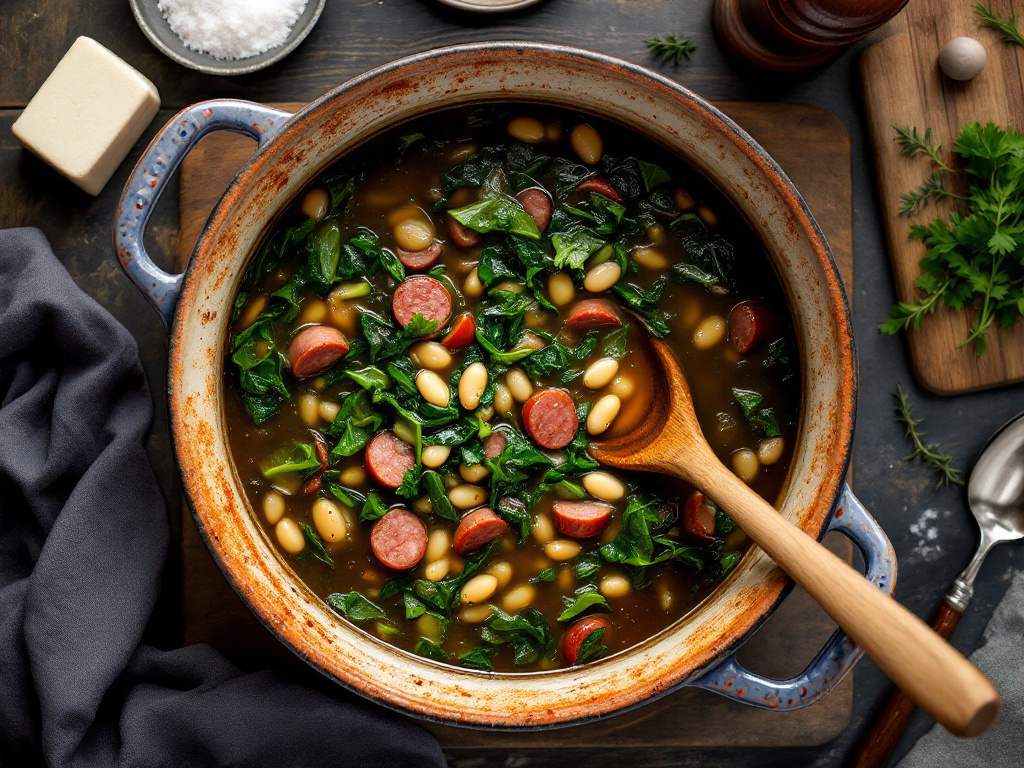
Ingredients List
- 2 bunches turnip greens (or other dark greens like kale or collard greens)
- 1 tablespoon olive oil
- 1 small yellow onion, diced
- 3 ribs celery, diced
- Salt and freshly ground black pepper, to taste
- 2 garlic cloves, minced
- 3/4 pound kielbasa or other smoked sausage, diced
- 2 (15-ounce) cans white beans, drained and rinsed
- 1 (15-ounce) can crushed or diced tomatoes
- 6 cups chicken broth
- 1 cup water
- 1 cup small pasta, like ditalini or orzo
- 1/4 cup chopped fresh parsley leaves, optional
Preparation Steps
- Sautéing Aromatics: Begin by sautéing onions, garlic, and diced turnip stems until fragrant. Heat the olive oil in a large pot over medium heat. Add the diced turnip stems, onion, and celery and sauté until the onion is translucent, about 4 minutes. Season with salt and pepper. Add the garlic and kielbasa and sauté for 3 more minutes.
- Adding Beans, Liquid, and Pasta: Add the drained beans, undrained tomatoes, chicken broth, and water. Increase the heat to high and add the lid. Bring to a simmer, reduce the heat to low, and cook for 10 minutes. To the simmering soup, stir in the pasta and chopped turnip leaves. Cook the pasta according to the package directions for al dente, stirring occasionally and adjusting the heat as needed to maintain a simmer.
- Simmering and Adding Greens: Stir in the chopped turnip leaves and let the soup simmer to allow the flavors to meld. Cook until the greens are tender and the flavors have combined, about 15-20 minutes.
Cooking Tips
- Adjust the seasoning to taste, adding more salt, pepper, or hot sauce as needed. Consider adding a splash of vinegar or lemon juice for brightness.
- Cook the pasta al dente to prevent it from becoming too soft in the soup. If you prefer a thicker soup, add less water or chicken broth.
- Slow Cooker Option: For a hands-off approach, combine all ingredients except the pasta in a slow cooker. Cook on low for 6-8 hours, adding the pasta during the last 30 minutes of cooking.
Serving Suggestions
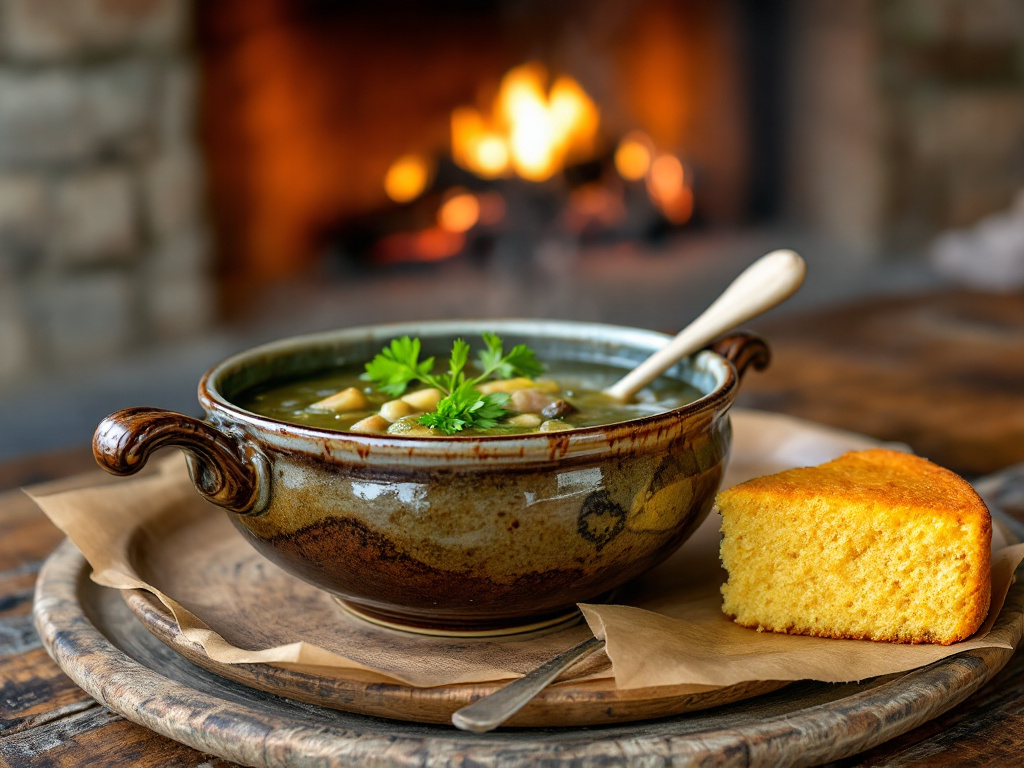
- Serve with cornbread or a side salad for a complete meal. Cornbread complements the soup’s flavors and adds a comforting touch. A side salad provides a refreshing contrast.
- Garnish with chopped parsley for added freshness. Consider adding a dollop of sour cream or Greek yogurt for creaminess.
- Presentation Ideas: Serve the soup in rustic bowls with a side of crusty bread. Garnish with a sprinkle of grated Parmesan cheese or a drizzle of olive oil for added elegance.
Nutritional Information
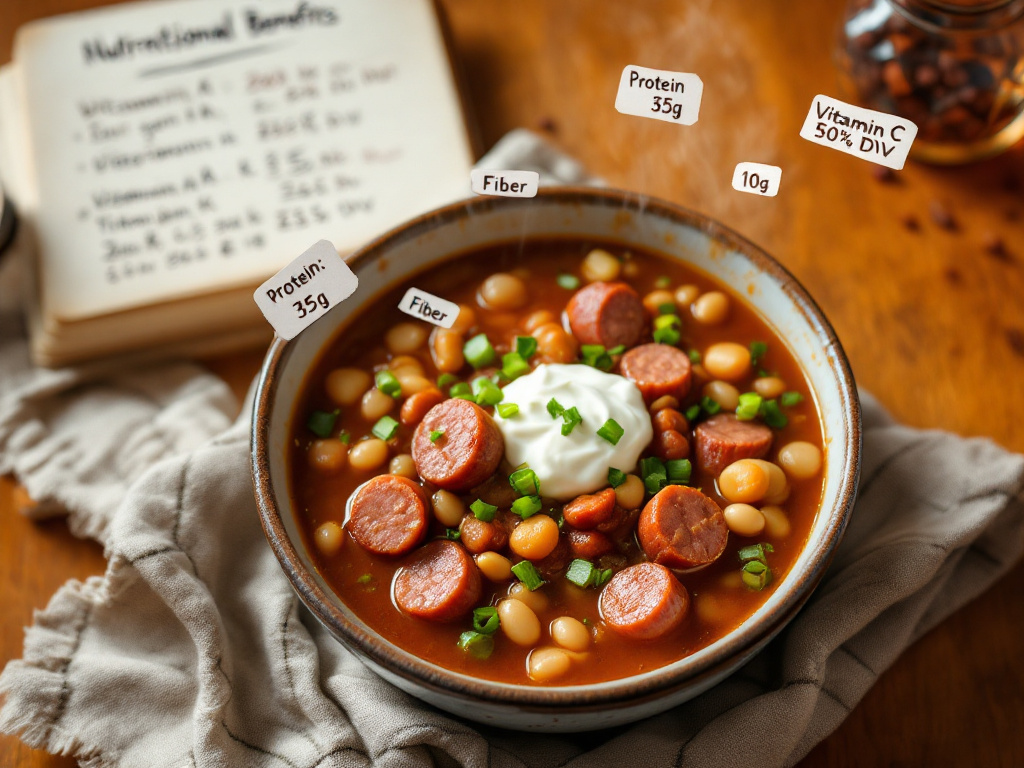
Swamp soup is not only delicious but also nutritious. It is packed with vitamins, minerals, protein, and fiber, making it a well-rounded meal. The soup is low in calories and high in flavor, making it an excellent choice for health-conscious individuals. Here’s a detailed breakdown of the nutritional content per serving:
- Calories: Approximately 350-400 calories per serving, depending on the ingredients used.
- Macronutrients:
- Protein: 20-25 grams, primarily from the beans and sausage.
- Carbohydrates: 40-45 grams, mainly from the beans, pasta, and vegetables.
- Fat: 10-15 grams, mostly from the sausage and olive oil.
- Micronutrients:
- Vitamin A: Essential for vision and immune function.
- Vitamin C: Important for skin health and immune function.
- Vitamin K: Crucial for blood clotting and bone health.
- Iron: Necessary for oxygen transport in the blood.
- Calcium: Vital for bone health and muscle function.
Storage and Reheating
- Storage: Store leftovers in an airtight container in the refrigerator for up to five days. To maintain freshness, allow the soup to cool before storing.
- Reheating: Reheat the soup on the stovetop or in the microwave, adding a little chicken broth if needed to adjust the consistency. Stir occasionally to prevent the soup from sticking or burning.
- Freezing Tips: Swamp soup freezes well. Store it in an airtight container in the freezer for up to three months. Thaw overnight in the refrigerator before reheating.
FAQs
-
Why is it called swamp soup?
- The name comes from the soup’s appearance, with greens floating on top, resembling a swamp. This rustic presentation reflects its hearty and comforting nature. The name also hints at its origins in regions with abundant swamplands.
-
Can you freeze swamp soup?
- Yes, swamp soup freezes well. Store it in an airtight container in the freezer for up to three months. Thaw overnight in the refrigerator before reheating. To maintain the best texture, avoid freezing the soup with pasta. Instead, cook the pasta separately and add it to the soup after reheating.
-
Can I make this a vegetarian soup?
- Yes, use vegetable broth and omit the sausage for a vegetarian version. Add extra vegetables or beans to enhance the soup. Consider adding mushrooms for a meaty texture and umami flavor. For a vegan version, ensure all ingredients are plant-based and use olive oil instead of butter for sautéing.
-
What can I serve with swamp soup?
- Serve with cornbread, a side salad, or crusty bread for a complete meal. Cornbread complements the soup’s flavors and adds a comforting touch. A side salad provides a refreshing contrast. Consider pairing the soup with a crisp white wine or a robust red wine for a well-rounded dining experience.
Health Benefits of Swamp Soup
Swamp soup is rich in nutrients, thanks to its key ingredients. Turnip greens are an excellent source of vitamins A, C, and K, while white beans provide protein and fiber. The smoked sausage adds flavor and protein, making the soup a balanced and satisfying meal. Here’s a deeper look into the health benefits:
- Heart Health: The fiber in beans and greens supports heart health by helping to lower cholesterol levels. The potassium in the soup also aids in regulating blood pressure.
- Digestive Health: The high fiber content promotes digestive health and helps prevent constipation. Fiber also supports a healthy gut microbiome.
- Immune Function: The vitamins and antioxidants in the greens and vegetables support immune function and help fight off infections.
- Bone Health: The vitamin K and calcium in the soup contribute to bone health and may help prevent osteoporosis.
Cultural Significance
Swamp soup is deeply rooted in Southern cuisine, reflecting the region’s history and culinary traditions. It is often served at family gatherings and community events, symbolizing hospitality and comfort. The soup’s simplicity and heartiness make it a beloved dish in many Southern households. Its cultural significance lies in its ability to bring people together and evoke a sense of home and belonging.
The soup’s origins are intertwined with the resourcefulness of Southern cooks, who have long made use of locally available ingredients to create delicious and hearty meals. Swamp soup is a testament to the ingenuity and adaptability of Southern cuisine, which has evolved over generations to incorporate various influences and flavors.
Tips for Making the Best Swamp Soup
Ingredient Selection
- Choose fresh, high-quality ingredients for the best flavor. Locally sourced turnip greens and smoked sausage are ideal for capturing the authentic taste of the South.
- Seasonal Ingredients: Use seasonal vegetables and herbs to enhance the soup’s flavor. For example, incorporate fresh thyme or rosemary for added depth.
Cooking Techniques
- Sauté the aromatics slowly to develop their flavors. This step is crucial for building the soup’s flavor foundation. Cook the onions, garlic, and celery until they are soft and fragrant.
- Simmer the soup gently to allow the flavors to meld without overcooking the ingredients. Stir occasionally to prevent the soup from sticking or burning.
- Cooking Pasta: To prevent the pasta from becoming too soft, cook it separately and add it to the soup just before serving. This technique ensures that the pasta retains its texture and doesn’t absorb too much liquid.
Seasoning Adjustments
- Taste the soup regularly and adjust the seasoning as needed. Consider adding a pinch of red pepper flakes for heat or a splash of vinegar for brightness.
- Balancing Flavors: Achieve a balance of flavors by combining savory, smoky, and slightly spicy elements. Adjust the seasoning to suit your preferences, adding more salt, pepper, or hot sauce as needed.
Presentation Ideas
- Serve the soup in rustic bowls with a side of cornbread. Garnish with chopped parsley or a drizzle of olive oil for added elegance.
- Creative Garnishes: Consider adding a dollop of sour cream or Greek yogurt for creaminess. Sprinkle grated Parmesan cheese or chopped fresh herbs for added flavor and visual appeal.
- Serving Style: Present the soup family-style, allowing guests to serve themselves. Provide additional toppings and sides, such as crusty bread or a side salad, for a complete meal.
Swamp Soup Around the World
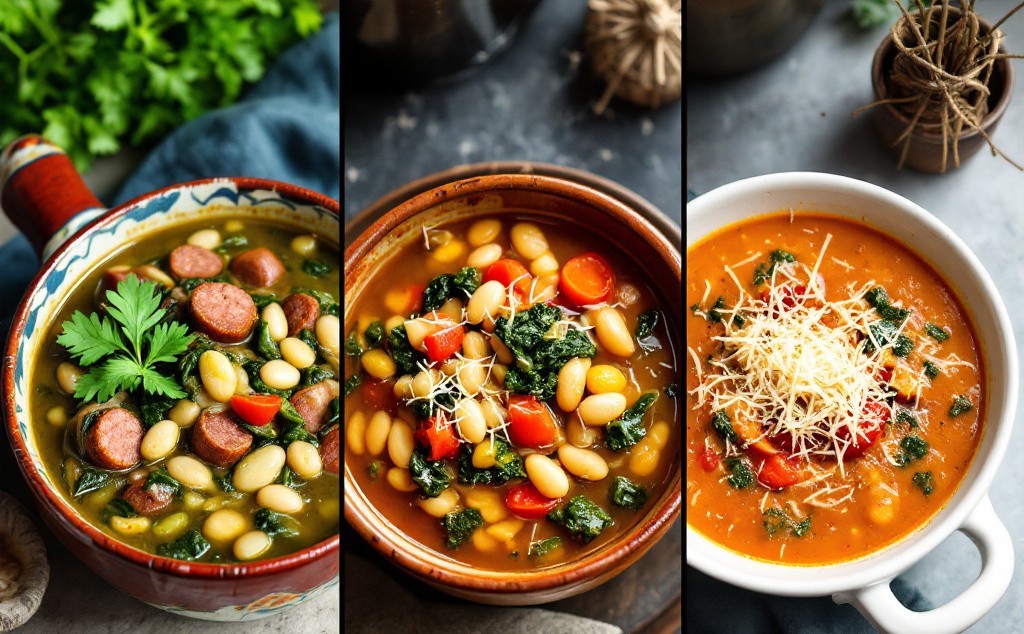
While swamp soup is a Southern specialty, variations of hearty greens and sausage soups can be found in different cultures. From Italian-inspired soups with kale and sausage to French-style soups with beans and greens, the concept of a hearty, comforting soup is universally appealing. Here are some international adaptations:
- Italian Influence: In Italy, a similar soup might feature kale, cannellini beans, and Italian sausage. This version often includes tomatoes and is seasoned with garlic, onion, and herbs like rosemary and thyme.
- French Inspiration: A French-style soup might incorporate white beans, greens like Swiss chard, and a variety of vegetables. It is often seasoned with herbes de Provence and enriched with a touch of cream or crème fraîche.
- German Variation: In Germany, a hearty soup might feature sauerkraut, smoked sausage, and potatoes. This version is often seasoned with caraway seeds, juniper berries, and mustard.
Conclusion
Swamp soup is more than just a meal; it is a comforting and nourishing dish that brings people together. Whether you are looking for a hearty meal to warm you up on a cold day or a delicious way to incorporate more greens into your diet, swamp soup is the perfect choice. With its rich flavors and versatile ingredients, this soup is sure to become a favorite in your household. So, grab your ingredients and get ready to enjoy a bowl of Southern comfort with this ultimate swamp soup recipe.
Experiment with the recipe, trying different combinations of greens, beans, and sausage to find your perfect blend. Share your creations with friends and family, and enjoy the joy of cooking and sharing a hearty, comforting meal.
For more hearty soup ideas, check out our ultimate guide to slow cooker soup recipes or explore our sausage soup recipes for additional inspiration. If you’re looking to enhance the flavor of your soups, don’t miss our tips on how to make homemade soup more flavorful.